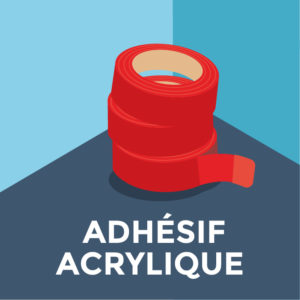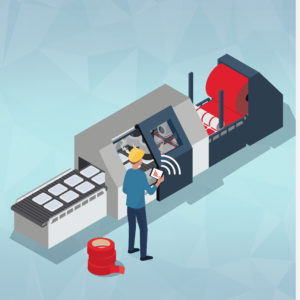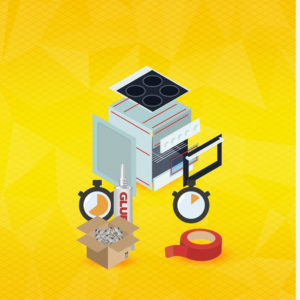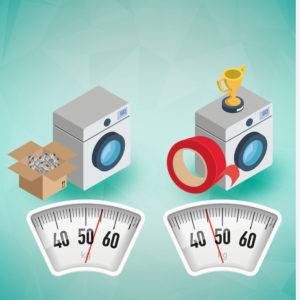

Tapes?
Adhesive tape is a substrate formed from a material coated with an adhesive mass that adheres via a simple press generally at ambient temperature.
Behind a simple appearance, adhesive tape is often a concentration of technologies that can be broken down into a multitude of applications in the professional and general public areas.
Adhesive tapes make it possible to respond economically and with performance to many functions: fastening, protecting & damping, masking, packaging, sealing, marking & signaling. These functions can sometimes be provided by the same product, this is then referred to as multi-functional adhesive tapes.




History
One of the first adhesive tapes was certainly an adhesive bandage at the end of the 19th century more commonly known as a plaster (invented in 1901).
It wasn’t until the 1920’s and the fast development of the automobile industry in particular in the United States that industrial uses appeared for adhesive tapes such as we know them today.
It is was in 1925 that the first adhesive tape for masking was invented by Richard Drew, a researcher at 3M, in order to meet the demand of vehicle coachbuilders who were using newspaper to paint cars with two colors. When the employees of the coachworks discovered this new adhesive tape for masking, they immediately concluded that 3M was looking to save on glue. They then baptized the product “Scotch®” or “Scotch® Tape” as it is well known, as we say “stingy as a Scotsman”! 3M adopted this name and made it its trademark. All Scotch® adhesive tapes then and now bear the famous Scottish tartan.
Then in the 30’s, other adhesives were launched in applications such as packaging. It it was above all in the 40’s during the war that adhesive tape had a remarkable boom, like many other emerging technologies. It was widespread post-war in offices, schools, companies and homes in different fields of use such as we know them today, such as fastening, masking, packaging, surface protection, emergency repairs, electrical and thermal insulation.




Composition and typology
Adhesive tape is a substrate formed from a material coated with an adhesive mass that adheres via a simple press generally at ambient temperature, ans is able to adapt to a large variety of substrates.
The two main families of adhesive tapes
There are two kinds of adhesive tapes :
- Single-sided adhesive tape
- Double-sided adhesive tape
Double-sided is formed from a substrate that is covered on both sides with an adhesive mass.
Single-sided is formed from a substrate that is covered on a single side with an adhesive mass.
The type of the substrates and masses are different according to the application. As such the tapes can meet a very large number of requirements such as resistance to high or low temperatures, resistance to UV aging, humidity, chemicals, solvents, impact, mechanical forces, etc.
It is by choosing the correct substrate and the correct adhesive mass that the constraints of the application can be satisfied.




The various types of adhesive masses
The main adhesives are:
- rubber adhesive:
This can be synthetic: adhesive tape obtained by the fusion of synthetic resin and thermoplastic gums. Or natural rubber with a solvent: comprised of natural rubber and resins diluted in a solvent mixture.
Its main properties are:- Highly versatile, low cost
- High tack and initial adhesion
- Limited durability, low resistance to chemical aggressions
- Low resistance at low and high temperature
- Indoor application, low resistance to plasticizers
The main applications are masking (paint, bodywork…), packaging, office, temporary gluing…
- acrylic adhesive
Aqueous base: adhesive comprised of acrylic resins in an aqueous dispersion.
Solvent base: adhesive comprised of acrylic resins in a solvent solution.
Its main properties are:- Medium initial adhesion, but high in the end
- Resistance to solvents, UV and humidity, to chemical stresses
- Temperature from -40°C to + 230°C, transparency
- Outdoor application, high resistance to aging
- High mechanical resistance
They are intended for high-performance applications such as permanent gluing.
- silicone adhesive
Comprised of silicone resins in a solvent solution
Its main properties are:- Excellent adhesion on silicone materials
- Excellent resistance to extreme temperatures (-70°C to +315°C)
- Low resistance to hydrocarbons and plasticizers
- Generally low initial adhesion
There are other adhesives such as polyurethane.
The various substrates
Substrates can be grouped into 5 families
- Polymer film substrates: polypropylene (PP), polyvinyl chloride (PVC), polyethylene terephthalate (PET), polyurethane (PU), EVA.
- Paper substrates
- Woven substrates – glass fiber, PET
- Polyethylene (PE), acrylic, PU, etc. foam substrates…
- Substrates made of metal – Aluminum….
Thus by taking account of the parameters of the application (temperature, duration, mechanical stresses, substrate to adhere, processing…), industry defines the type of adhesive, and the substrate that are the most suitable. Hundreds of combinations are possible and today there are thousands of different adhesives that satisfy applications as basic as closing a box, to those that are highly technical such as gluing smartphones, vehicle batteries, masking paint in transports (automobile, aeronautics…).
The various protectors
Substrates can be grouped into 2 families
- Paper: silicone paper (standard solution) or paper coated with Polyethylene (paper that resists humidity and that can be printed)
- Films: Polypropylene (PP), Polyethylene (PE) or polyethylene terephthalate (PET)
Protectors are present only in the composition of “double-sided” adhesive tapes.


Process for use
Adhesive tape can be used manually but also automatically in industry, in particular because it can have different forms such as rollers, pre-cut forms (e.g: disks), spools of great lengths (up to 20,000 meters in certain applications)






The main markets
Automobile
Worldwide automobile production (private vehicles and utility vehicles) is approaching 100 million units, 19 million units are assembled in Europe, more than 2 million in France. The maintenance/repair market concerns an automobile fleet of 390 million units in Europe and 39 million units in France (Source: OICA – CCFA)
The “Upstream” sector includes 4,000 companies, and represents 440,000 employees
The “Downstream” sector: 145,000 companies and 550,000 employees
Turnover: €155 billion of which €49 billion in exports and €6 billion in R&D investment per year (Source CNI – France)
Aviation
The French sector is structured around a limited number of major assembly makers (Airbus, Airbus Helicopter, Dassault Aviation), engine manufacturers (Snecma and Turbomeca of the Safran group), supplier equipment manufacturers of complete sub-assemblies (Safran, Thales, etc.) and the major rank 1 subcontractors (Latécoère, Daher-Socata, Stelia, Lisi, Liebherr, Aubert & Duval, etc.), who provide work to a fabric of subcontractors and service providers estimated at more than 3,000 companies, primarily SMEs.
300,000 direct and indirect jobs
TO 2017: €54.8 billion of which 90% in exports
#1 contributor to France’s positive foreign trade balance (Source: CNI)
Construction
The construction market is structured around three segments:
- Housing construction: 420,000 housing units launched in 2018 in France of which 60% collective housing (Source Sit@del2)
- Construction of premises: offices, commercial, industrial and administrative buildings, warehouses, hotel accommodation… 27 million m2 launched in France in 2018
- Maintenance / repair estimated, in France, at 36 million housing units + non-residential premises
Paper and printing
The sector is organized around several activities:
- Manufacture of paper and cardboard
- Printing (newspapers, printed items, catalog, books, household packaging, labels…) via offset, screen printing, digital or flexography.
Adhesive tapes are used as connectors and closures of spools, fastenings for photographic shots in Flexography, etc.
Electronics
Electronics industries number 1,100 specialized companies in France and employ 100,000 people. Its turnover is €15 billion
Other
Medical
Stationery
Scrapes: the various types of adhesive tapes on an automobile, aircraft, building, etc.










Advantages
Today, industries are confronted with many challenges:
- Improving the energy efficiency of products:
- Structure lightening (transports…)
- Insulation (construction…)
- Meeting, and even anticipating, environmental expectations (regulatory and society),
- Hygiene and Safety
- Improving the productivity of processes
- Facilitating the designing of parts
- Improving product reliability and durability
The advantages of adhesive tapes with respect to other assembly technologies
Advantages of Adhesive tapes with respect to mechanical fastenings:
- Possibility of fastening different types of materials
- Less complex part design (no threading…)
- Structure lightening
- Tightness
- Reduction in vibrations and noise
Advantages of Adhesive tapes with respect to adhesives:
- Gain in productivity: no polymerization time
- Financial gains:
- Less workshop surface area vs. space needed for the time for parts to set
- Unnecessary protection against Volatile Organic Compounds (vs. solvent adhesives)
- Less investment for production equipment
Facilitating the designing of parts
Using adhesive tapes allows for a streamlined design:
- Simplify the design of parts to be assembled (no drilling, welding…). Die cutting, i.e. cutting the adhesive to the exact geometry of the part to be assembled forms a commonly-used solution
- an assembly that is not visible, contrary to mechanical fastenings (screws, rivets…)
- fastening of materials of a heterogeneous nature (metal/composite/plastic…)
removable or definitive assemblies - a lightening of the structures carried out
- sealing the assemblies carried out
- reducing vibrations and noise
Reducing the impact on the environment
Using adhesive tapes enables the impact on the environment to be reduced by making it possible to:
- lighten the structures (source of energy efficiency in transports) due to:
- a possibility of assembling light and heterogeneous materials
- an intrinsic weight of a fastening with an adhesive tape that is less than that of a mechanical fastening
- filter vibrations
- reduce sound emissions
- reduce, and even suppress, emissions of Volatile Organic Compounds (VOC) (*)
(*) Using adhesive tapes emits less or nothing compared to adhesives. Therefore, it is not necessary to install expensive equipment to recover VOCs.
Improving the productivity of the assembly
Assembling parts with adhesive tapes, via automatic or semi-automatic deposition, is carried out at low cost compared to an assembly via welding, screws, riveting or by gluing. Processing time is less and the quality is better.
Customized cutting of the adhesive tape (“Die Cut”), makes it possible to optimize the assembly of the parts and allows a substantial amount of time to be saved during processing.
The absence of polymerization time contrary to assemblies by adhesives, reduces production times.
Finally, the simplification of the design of parts to be assembled (no operations of drilling…) lowers development and manufacturing costs.
Simplification of the design for fastening vs. screws/welding=> drop in development and manufacturing costs


